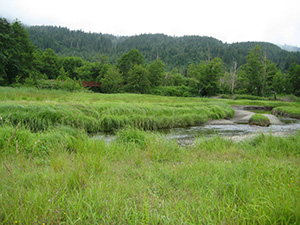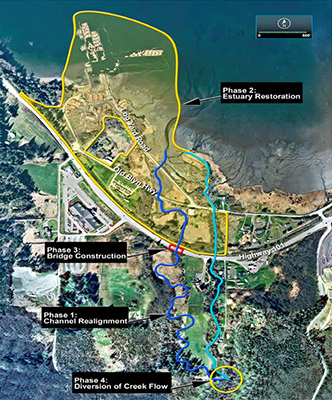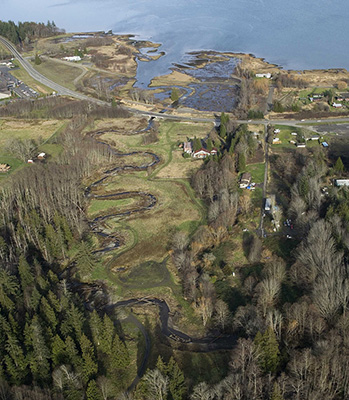Awards
Exemplary Ecosystem Initiatives — 2011
Washington: Jimmycomelately Ecosystem Restoration

Figure 1. The Jimmycomelately creek was realigned into its naturally-occuring path.
Source: WSDOT
The Jimmycomelately (JCL) Ecosystem Restoration works to minimize human impacts on the Jimmycomelately-Sequim Bay ecosystem in Blyn, Washington, and restore historical ecological functions to this area. Over 27 partners came together to collaborate on an ecosystems-based approach to restore this environment to its natural state after years of human disturbances.
The JCL Creek is a major tributary of Sequim Bay, and its watershed covers approximately 15.4 square miles. While the JCL ecosystem was once a connected linkage of habitats, human activities have fragmented this environment. Logging, road and residential development, railroad construction, and wetland draining have all disturbed the JCL ecosystem. To assist in Blyn's development as a town, the JCL Creek was relocated, channelized, dredged, and straightened. These actions have affected local fish species and increased flood risks for nearby property owners.
The JCL Ecosystem Restoration project aims to restore the JCL ecosystem by improving aquatic habitats, water quality, wildlife passage under US 101, and reducing flood risks. As part of this effort, JCL Creek was realigned into a naturally-occurring path, helping to restore the estuary habitat and strengthen the connection between the creek and bay's continuous tides. Fish populations and water quality have both benefited from this realignment, and annual flooding is no longer as severe.
Removal of human infrastructure has also helped to restore the JCL ecosystem. The JCL Ecosystem Restoration project removed old log yard infrastructure, including a road, pilings, a nearby pier, and fill. The project restored the shoreline to its historical state, which had been altered by the log yard and other modifications dating back to 1870. While it was active, the logging operation also altered the course of nearby Dean Creek. The JCL Ecosystem Restoration project realigned this creek to its natural path through the log yard, and removed a portion of Old Blyn Highway, which serviced the log yard and cut through the JCL estuary.
In addition to mitigating impacts from the old log yard, the JCL Ecosystem Restoration project also considered public access, wildlife passage, and revegetation of native plants. The project added public access and interpretative signage to support the Olympic Discovery Trail, a 126-mile hiking, bicycle, and equestrian trail running through the State's Olympic Peninsula. The project constructed a new bridge on US 101 to support wildlife and fish passage and flood flows. To encourage new habitat growth, the project also installed large woody material and native plantings which now line the channel, floodplain, and estuary.
For more information, contact Carl Ward, Washington State Department of Transportation, at wardc@wsdot.wa.gov.

Figure 2: Map of the Jimmycomelately ecosystem restoration project area
Source: Randy Johnson, Jamestown S'Klallam Tribe

Figure 3: Aerial photo of the restored Jimmycomelately Creek and estuary
Source: David Woodcock, Greywolf Photography

